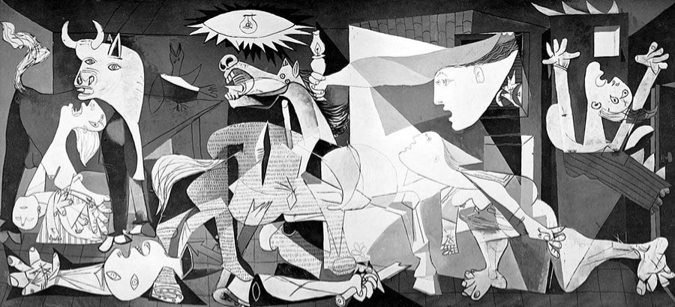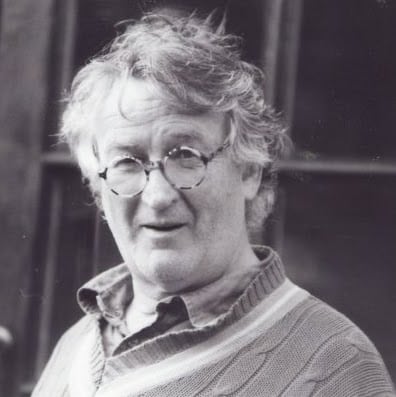Arne Jacobsen’s St Catherine’s College Oxford, Refectory
[dropcap style=”font-size:100px;color:#992211;]S[/dropcap]hould we prefer soft voluptuous curves or hard aggressive angles? It all depends
It is alarming, to those of us who have spent time considering aesthetics and the attitude to adopt toward works of art, to discover that PhD research in psychology and related disciplines puts forward a causal model.
Why so?
A lecture given at a school of art in 1968 referred to that fact that when horses were put in a red stable they behaved impatiently and aggressively. Whilst horses put in a pale blue stable were calm and behaved peaceably. So, the students were instructed, colours have a psychological impact.
Many years later a student contradicted her tutor claiming that the facts are that we recoil from some colours because we fear poisons, which are naturally coloured brownish green. The tutor pointed out that many good paintings contain brownish green but to no avail.
Where to begin?
When we look at a painting the correct causal story has it that light reflected from its surface provides us with sensations. But that’s it. Our appreciation of paintings, music and architecture is not sensational – or at least it is not merely sensational. It is intentional.
Intentionality, philosophers agree, is where meaning gets into the sensations. But meaning is something over and above sensation. We need to think within an entire context to appreciate works of art.
Horses inhabit no such context and so their reactions to coloured interiors is to be explained causally. Dare I say it – psychologically? Not so, our appreciation of the arts.
Our aesthetic appreciation of architecture needs to consider our classical heritage, even if we wish, as many architects have, to stand classicism on its head. When I appreciate a building it is as if thoughts of inhabitation, of tradition (again, even when wanting to produce or dwell in the avant-garde); and of its place in the larger surroundings.
Arne Jacobsen’s StCatherines College, Oxford inverts the classical tradition, which we understand as an architecture of stacking.
Instead he uses a glazed strip which dips under the beams to express the fact that the walls do not support the roof. The roof rests upon beams, themselves supported by interior columns. What makes it so modern is that it turns its back on Classicism.
Aesthetic interest is directed toward a work of art. It is not, therefore, caused by it. When I look at Picasso’s Guernica, it is with thoughts of the terrible historical massacre inflicted on that city by the Luftwaffe in their rehearsal of carpet and incendiary bombing raids. One sees in that painting Picasso’s horror at the violence in his beloved Spain.

Pablo Picasso, Guernica, oil on canvas
The woman with the dead child in her arms brings home the real personal agonies inflicted upon individuals in war.
What is more, the invention of cubism makes all manner of expression available to Picasso and he this he uses to terrifying effect in that painting. (See Natalie Andrews’ piece on Modernism in this journal).
Curves or angles? It depends upon so much more than simple animal psychology.
_______________________________________________________________________________
Curves or angles? Shapes in businesses affect customer response
Study finds angular shapes suggest competence to consumers

CREDIT: OHIO STATE UNIVERSITY
COLUMBUS, Ohio – When you’re waiting in a busy restaurant or doctor’s office, it may matter whether the tables, light fixtures and other objects are round or square.
In a laboratory study, researchers found the shape of physical objects in a service business affected customer satisfaction, depending on how crowded the business was in the experimental scenarios.
Angular shapes suggested competence to customers, which increased their level of satisfaction when the business was busy. In contrast, circles suggested friendliness and warmth to customers, which increased their satisfaction when the business was not crowded.
“Just manipulating this subtle environmental cue had an influence on customer satisfaction in our study,” said Stephanie Liu, lead author of the research and assistant professor of consumer sciences at The Ohio State University.
The findings may seem odd, but the effect of shapes on people has long been studied in fields such as psychology, marketing and architecture, said Vanja Bogicevic, co-author of the study and a doctoral student in consumer sciences at Ohio State.
“For example, circles and angles are used in very deliberate ways in urban design to convey meaning,” said Bogicevic, who is a former architect.
Circles are a signal of warmth due to their resemblance to the sun, and suggest harmony and friendliness. Hard angles are generally found in human-made objects – think street grids in cities – and so have an association with competence, toughness and strength.
This is the first time researchers have explored the impact of circular and angular shapes on consumer response in the service industry, according to Liu.
The study appears online in the Journal of Business Research and will be published in the August 2018 print edition. Liu and Bogicevic conducted the study with Anna Mattila, a professor at Pennsylvania State University.
The researchers did two related studies.
The first study involved 166 adults who participated online. They were given a scenario in which they imagined themselves eating at a restaurant named Tarragon with a friend. Half the people were shown pictures around the restaurant in which the restaurant logo, ceiling lights, a flower vase, candles, wall paintings and tables all had rounded shapes. The other half saw the same objects, but they all had straight lines and sharp corners.
Some participants were told there were no customers in the waiting area, while others were told it was crowded.
The rest of the scenario was the same for all participants and described a pleasant meal with good food and fast service.
After reading the scenario, all participants were asked how they thought they would rate their server in terms of warmth and friendliness and in terms of competence.
Participants were then asked several questions in which they rated how satisfied they thought they would be in this scenario and how likely they would be to recommend this restaurant to others and to visit again.
Remember, the only way the scenarios differed for study participants was how crowded the restaurant was, and the shape of the physical objects in the space.
But those two factors interacted in a way that had a significant effect on how they rated their satisfaction with and loyalty to the restaurant, Liu said.
When the restaurant was not busy, participants who saw the environment with the rounded edges reported higher levels of satisfaction and loyalty. But when the restaurant was busy, the angular environment led to more satisfaction and loyalty.
Why was that? When the restaurant was not busy, the circular shapes focused customers’ attention on the warmth and friendliness of their server, which then led to more satisfaction, Liu said.
But when the restaurant was busy, it was the angular shapes that were more likely to prompt participants to rate their server as competent, which led to higher levels of satisfaction.
“We used shapes to influence perceptions about the employees’ behavior,” Liu said. “The shapes helped determine what the participants focused on.”
A second study replicated the results with a different group of participants – 245 university faculty, staff and students – and a different scenario, this being a visit to a health care facility to be treated for an illness.
The results were the same as the first study, Liu said.
These findings fit neatly into the growing body of research on sensory marketing, which examines how things like color, touch and smell all influence consumer perceptions, attitude and behavior.
“The effect of shape on consumers is a new direction for sensory marketing,” Bogicevic said.
Liu said the study suggests one way that service businesses can provide fast service to many customers while still maintaining customer satisfaction.
“The physical environment of service businesses can be designed in such a way as to maximize customer satisfaction. Shapes are an important part of that,” Liu said.
###
Contact: Stephanie Liu, 614-292-7184; Liu.6225@osu.edu
Vanja Bogicevic, Bogicevic.1@osu.edu
Written by Jeff Grabmeier, 614-292-8457; Grabmeier.1@osu.edu

Ed studied painting at the Slade School of Fine Art and later wrote his PhD in Philosophy at UCL. He has written extensively on the visual arts and is presently writing a book on everyday aesthetics. He is an elected member of the International Association of Art Critics (AICA). He taught at University of Westminster and at University of Kent and he continues to make art.




















